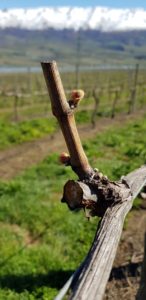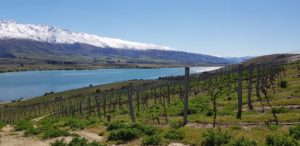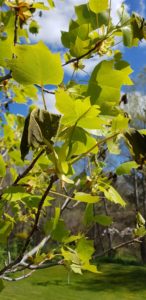Misha looks at the recent frosts and why frost drained site selection is such an important consideration for a vineyard.
News of this type gets the region in full frost-fighting mode especially when the forecasts indicate an 80% likelihood of the forecast being correct and so early in the growing season! All forms of frost-fighting equipment ie wind machines, various types of water sprinklers, and even frost pots were made ready across the region. Many of the bigger and more frost prone vineyards alerted helicopters to be on standby for the night.
I must admit I didn’t sleep much that night. We could feel the temperature dropping as the cloud cover cleared. We don’t live on the vineyard but we’re not far away. The night was eerily still with absolutely no wind – all we could hear was the faint whir of wind machines and helicopters in the distance. We just crossed our fingers and hoped the vineyard would be OK.
Next morning, Aaron, our tractor driver who lives on-site at the vineyard, came into our Tasting Room early and reported that he had been up a lot of the night too, as he felt the temperatures drop and figured it was about 3.30am that our vineyard went below 0 C. He said that directly across Lake Dunstan from the vineyard, it looked and sounded like a war zone. Where it’s usually pitch black, he saw the flashing red lights of helicopters as they hovered above many of the vineyards hoping to stir up any inversion layer and various lights of vehicles moving around the landscape no doubt with worried vineyard managers trying to protect the vineyards. And he could definitely hear wind machines whirring at full speed as they tried to move the cold air around. This was a critical time for vines with bud burst just a few weeks back and now the vines with their first few delicate leaves.

By the Monday, Tim, our Vineyard Manager, after two detailed post-frost inspections, gave us his report. He admitted he had been worried as the Bendigo sub-region certainly was hit hard by the frost, as were all the other sub-regions. Often some of the higher blocks at Bendigo manage to escape some of the frosts but it wasn’t the case this time.
Thankfully, the good news we’d hoped for was that most of our blocks at Misha’s Vineyard escaped damage pretty well with just some scarring around the edges of leaves on a few vines and the odd dead shoot randomly. Our Dress Circle where we grow our Pinot Gris showed some minor impact, as well as some of our Gewurztraminer in the Fruit Bowl block. However there are plenty of buds and shoots that are healthy to replace the few that are damaged – so it just means we don’t need to do as much shoot thinning on those vines. Our Pinot Noir across the vineyard came through well with very minor damage considering we had close to -2C for several hours. Our Riesling and Sauvignon Blanc on the steeper slopes were all absolutely fine. Overall Tim was confident there was nothing that would result in any reduction in yields.

We have been reading a lot about frost in the past few days and New Zealand Winegrowers, our national body, has posted information about frost as many regions across New Zealand have experience frost over the last week. Notes from a Romeo Bragatao Conference workshop on frost from back in 2003 were re-posted and it has been interesting to read these and understand the impact of frost on vine development and to understand how to be better prepared for future frosts. We smiled when reading the last line in these notes : “Appropriate site selection is still considered the best means of frost protection”.
Andy and l looked for two years for a “frost free” site on which to establish Misha’s Vineyard. Our west-facing, steep slopes with plenty of rock to soak up afternoon sun, and a location on the west side of Lake Dunstan with the Dunstan Mountain range which isn’t as snow prone as the Pisa Range on the other side, are all things that keep us as safe as we can be. We don’t have wind machines on the vineyard (as our multi-level steep slopes aren’t suitable) and power lines would impact the ability for helicopters to fly around trying to find an inversion layer to push down. All I can say is ‘Phew!’. Thank goodness we spent the time on site selection” especially when we’re ‘on the edge’ in terms of grape growing!
